Nestle and Starbucks: Marketing Techniques and Analysis Report
VerifiedAdded on 2020/07/22
|11
|2889
|80
Report
AI Summary
This report provides a comprehensive analysis of the marketing strategies employed by Nestle and Starbucks. It begins with an introduction to marketing concepts and then delves into the specific marketing techniques used by each company, including branding and relationship marketing. The report examines the limitations and constraints of marketing, such as voluntary advertising codes and consumerism. It explores how Nestle utilizes market research to inform its marketing plans, including primary and secondary research methods, and how marketing research contributes to the development of marketing planning through SWOT and PESTLE analyses. The report further investigates customer targeting strategies, including market segmentation based on geographic, demographic, and psychographic factors. Finally, it discusses the development of the marketing mix (product, price, place, and promotion) for new products and services, providing a detailed overview of the marketing practices of these two prominent companies.
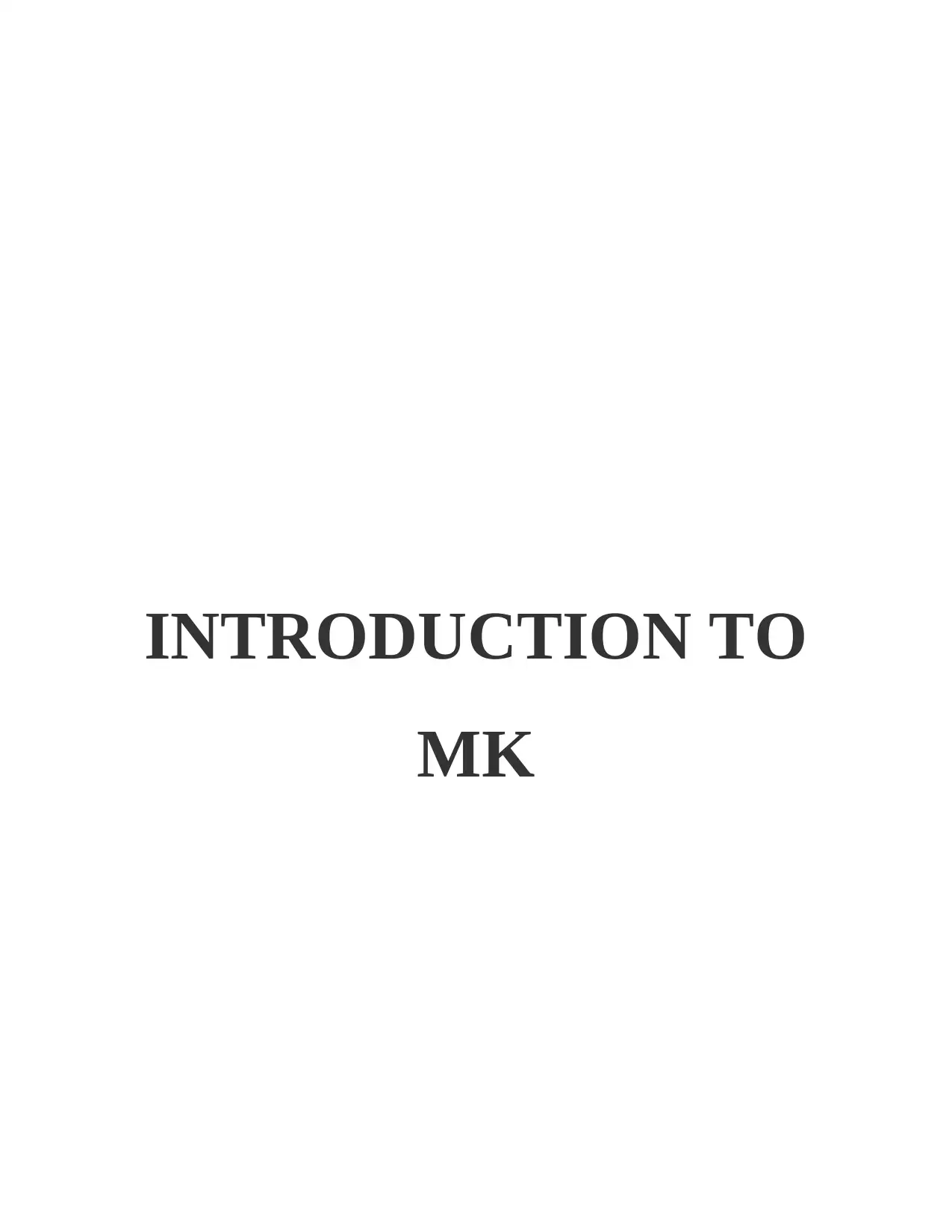
INTRODUCTION TO
MK
MK
Paraphrase This Document
Need a fresh take? Get an instant paraphrase of this document with our AI Paraphraser
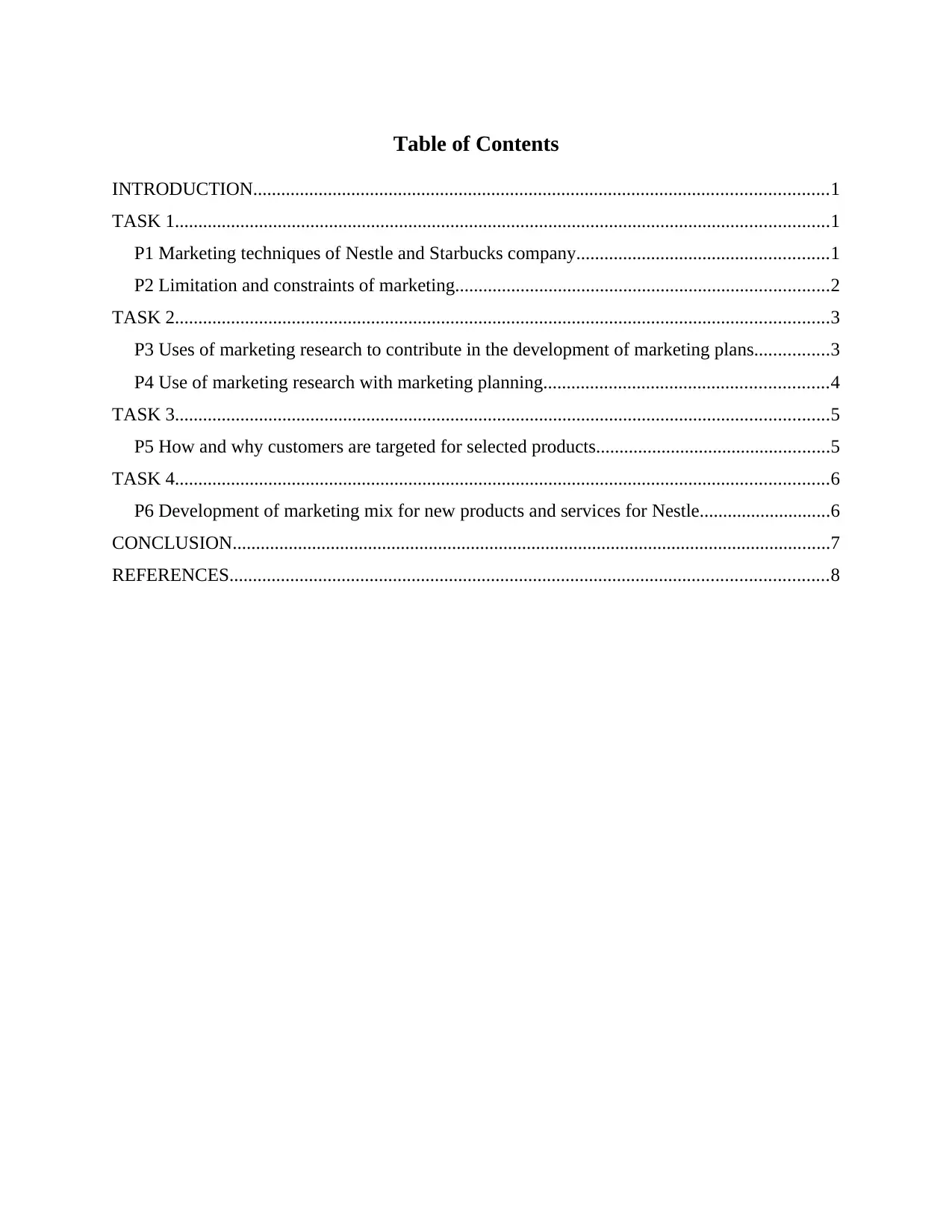
Table of Contents
INTRODUCTION...........................................................................................................................1
TASK 1............................................................................................................................................1
P1 Marketing techniques of Nestle and Starbucks company......................................................1
P2 Limitation and constraints of marketing................................................................................2
TASK 2............................................................................................................................................3
P3 Uses of marketing research to contribute in the development of marketing plans................3
P4 Use of marketing research with marketing planning.............................................................4
TASK 3............................................................................................................................................5
P5 How and why customers are targeted for selected products..................................................5
TASK 4............................................................................................................................................6
P6 Development of marketing mix for new products and services for Nestle............................6
CONCLUSION................................................................................................................................7
REFERENCES................................................................................................................................8
INTRODUCTION...........................................................................................................................1
TASK 1............................................................................................................................................1
P1 Marketing techniques of Nestle and Starbucks company......................................................1
P2 Limitation and constraints of marketing................................................................................2
TASK 2............................................................................................................................................3
P3 Uses of marketing research to contribute in the development of marketing plans................3
P4 Use of marketing research with marketing planning.............................................................4
TASK 3............................................................................................................................................5
P5 How and why customers are targeted for selected products..................................................5
TASK 4............................................................................................................................................6
P6 Development of marketing mix for new products and services for Nestle............................6
CONCLUSION................................................................................................................................7
REFERENCES................................................................................................................................8

⊘ This is a preview!⊘
Do you want full access?
Subscribe today to unlock all pages.

Trusted by 1+ million students worldwide
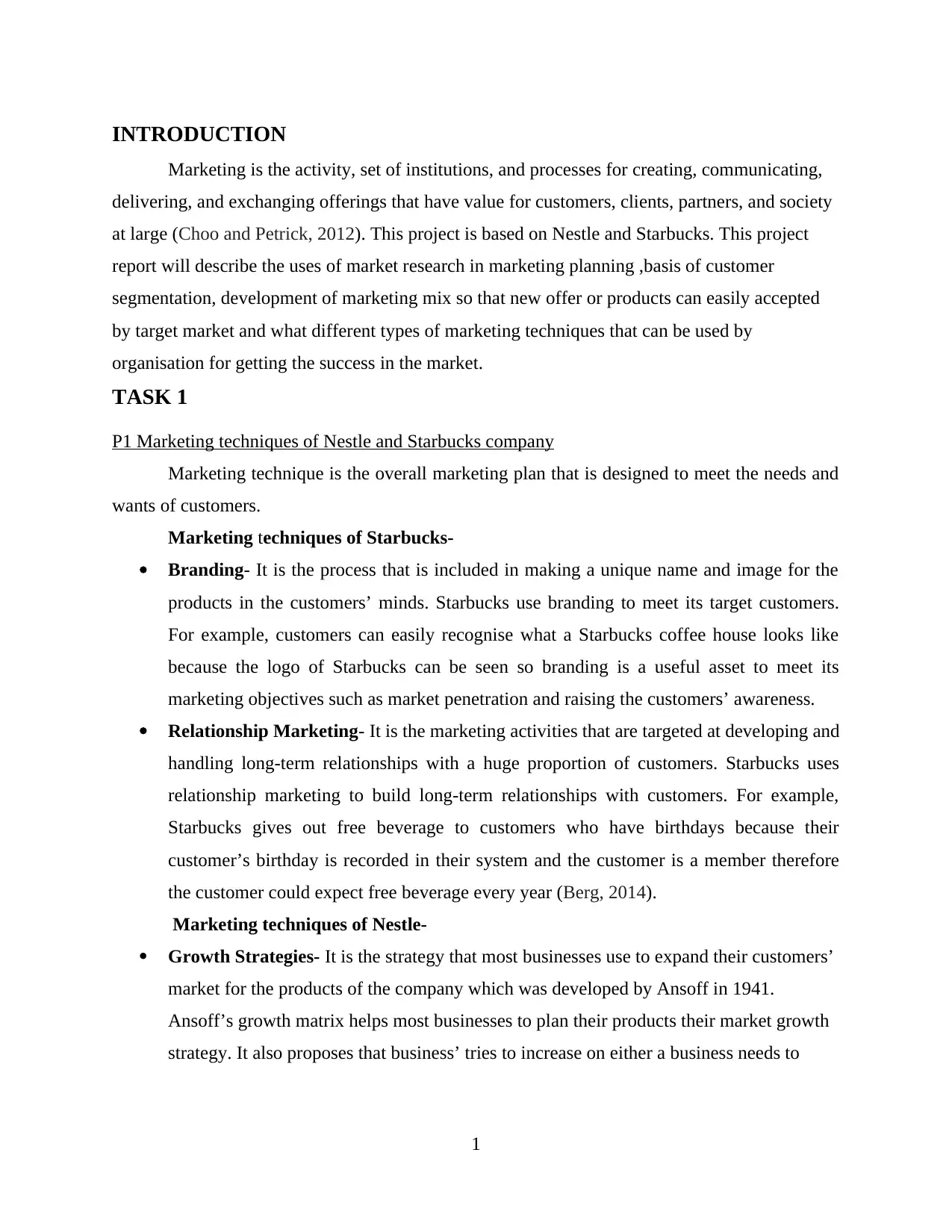
INTRODUCTION
Marketing is the activity, set of institutions, and processes for creating, communicating,
delivering, and exchanging offerings that have value for customers, clients, partners, and society
at large (Choo and Petrick, 2012). This project is based on Nestle and Starbucks. This project
report will describe the uses of market research in marketing planning ,basis of customer
segmentation, development of marketing mix so that new offer or products can easily accepted
by target market and what different types of marketing techniques that can be used by
organisation for getting the success in the market.
TASK 1
P1 Marketing techniques of Nestle and Starbucks company
Marketing technique is the overall marketing plan that is designed to meet the needs and
wants of customers.
Marketing techniques of Starbucks-
Branding- It is the process that is included in making a unique name and image for the
products in the customers’ minds. Starbucks use branding to meet its target customers.
For example, customers can easily recognise what a Starbucks coffee house looks like
because the logo of Starbucks can be seen so branding is a useful asset to meet its
marketing objectives such as market penetration and raising the customers’ awareness.
Relationship Marketing- It is the marketing activities that are targeted at developing and
handling long-term relationships with a huge proportion of customers. Starbucks uses
relationship marketing to build long-term relationships with customers. For example,
Starbucks gives out free beverage to customers who have birthdays because their
customer’s birthday is recorded in their system and the customer is a member therefore
the customer could expect free beverage every year (Berg, 2014).
Marketing techniques of Nestle-
Growth Strategies- It is the strategy that most businesses use to expand their customers’
market for the products of the company which was developed by Ansoff in 1941.
Ansoff’s growth matrix helps most businesses to plan their products their market growth
strategy. It also proposes that business’ tries to increase on either a business needs to
1
Marketing is the activity, set of institutions, and processes for creating, communicating,
delivering, and exchanging offerings that have value for customers, clients, partners, and society
at large (Choo and Petrick, 2012). This project is based on Nestle and Starbucks. This project
report will describe the uses of market research in marketing planning ,basis of customer
segmentation, development of marketing mix so that new offer or products can easily accepted
by target market and what different types of marketing techniques that can be used by
organisation for getting the success in the market.
TASK 1
P1 Marketing techniques of Nestle and Starbucks company
Marketing technique is the overall marketing plan that is designed to meet the needs and
wants of customers.
Marketing techniques of Starbucks-
Branding- It is the process that is included in making a unique name and image for the
products in the customers’ minds. Starbucks use branding to meet its target customers.
For example, customers can easily recognise what a Starbucks coffee house looks like
because the logo of Starbucks can be seen so branding is a useful asset to meet its
marketing objectives such as market penetration and raising the customers’ awareness.
Relationship Marketing- It is the marketing activities that are targeted at developing and
handling long-term relationships with a huge proportion of customers. Starbucks uses
relationship marketing to build long-term relationships with customers. For example,
Starbucks gives out free beverage to customers who have birthdays because their
customer’s birthday is recorded in their system and the customer is a member therefore
the customer could expect free beverage every year (Berg, 2014).
Marketing techniques of Nestle-
Growth Strategies- It is the strategy that most businesses use to expand their customers’
market for the products of the company which was developed by Ansoff in 1941.
Ansoff’s growth matrix helps most businesses to plan their products their market growth
strategy. It also proposes that business’ tries to increase on either a business needs to
1
Paraphrase This Document
Need a fresh take? Get an instant paraphrase of this document with our AI Paraphraser
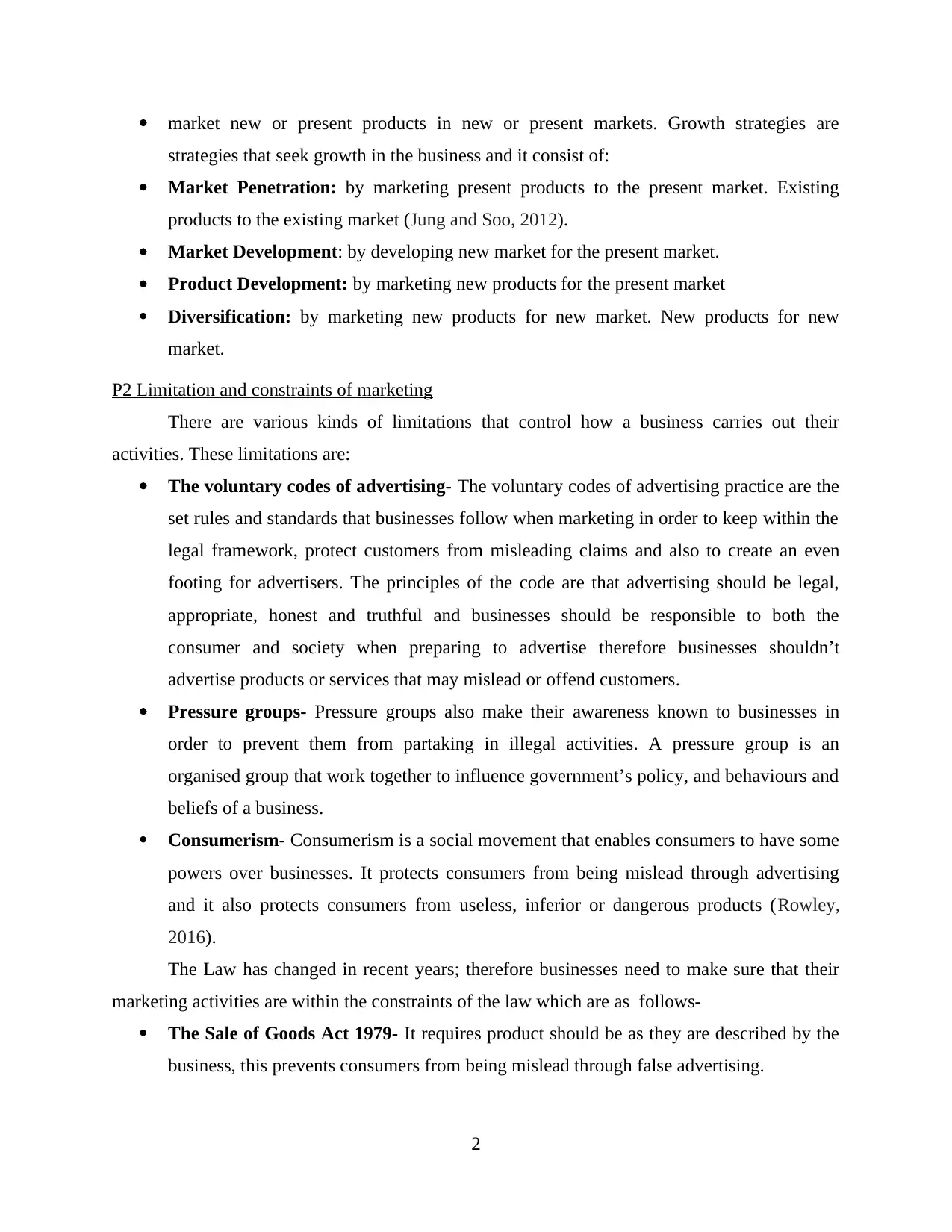
market new or present products in new or present markets. Growth strategies are
strategies that seek growth in the business and it consist of:
Market Penetration: by marketing present products to the present market. Existing
products to the existing market (Jung and Soo, 2012).
Market Development: by developing new market for the present market.
Product Development: by marketing new products for the present market
Diversification: by marketing new products for new market. New products for new
market.
P2 Limitation and constraints of marketing
There are various kinds of limitations that control how a business carries out their
activities. These limitations are:
The voluntary codes of advertising- The voluntary codes of advertising practice are the
set rules and standards that businesses follow when marketing in order to keep within the
legal framework, protect customers from misleading claims and also to create an even
footing for advertisers. The principles of the code are that advertising should be legal,
appropriate, honest and truthful and businesses should be responsible to both the
consumer and society when preparing to advertise therefore businesses shouldn’t
advertise products or services that may mislead or offend customers.
Pressure groups- Pressure groups also make their awareness known to businesses in
order to prevent them from partaking in illegal activities. A pressure group is an
organised group that work together to influence government’s policy, and behaviours and
beliefs of a business.
Consumerism- Consumerism is a social movement that enables consumers to have some
powers over businesses. It protects consumers from being mislead through advertising
and it also protects consumers from useless, inferior or dangerous products (Rowley,
2016).
The Law has changed in recent years; therefore businesses need to make sure that their
marketing activities are within the constraints of the law which are as follows-
The Sale of Goods Act 1979- It requires product should be as they are described by the
business, this prevents consumers from being mislead through false advertising.
2
strategies that seek growth in the business and it consist of:
Market Penetration: by marketing present products to the present market. Existing
products to the existing market (Jung and Soo, 2012).
Market Development: by developing new market for the present market.
Product Development: by marketing new products for the present market
Diversification: by marketing new products for new market. New products for new
market.
P2 Limitation and constraints of marketing
There are various kinds of limitations that control how a business carries out their
activities. These limitations are:
The voluntary codes of advertising- The voluntary codes of advertising practice are the
set rules and standards that businesses follow when marketing in order to keep within the
legal framework, protect customers from misleading claims and also to create an even
footing for advertisers. The principles of the code are that advertising should be legal,
appropriate, honest and truthful and businesses should be responsible to both the
consumer and society when preparing to advertise therefore businesses shouldn’t
advertise products or services that may mislead or offend customers.
Pressure groups- Pressure groups also make their awareness known to businesses in
order to prevent them from partaking in illegal activities. A pressure group is an
organised group that work together to influence government’s policy, and behaviours and
beliefs of a business.
Consumerism- Consumerism is a social movement that enables consumers to have some
powers over businesses. It protects consumers from being mislead through advertising
and it also protects consumers from useless, inferior or dangerous products (Rowley,
2016).
The Law has changed in recent years; therefore businesses need to make sure that their
marketing activities are within the constraints of the law which are as follows-
The Sale of Goods Act 1979- It requires product should be as they are described by the
business, this prevents consumers from being mislead through false advertising.
2
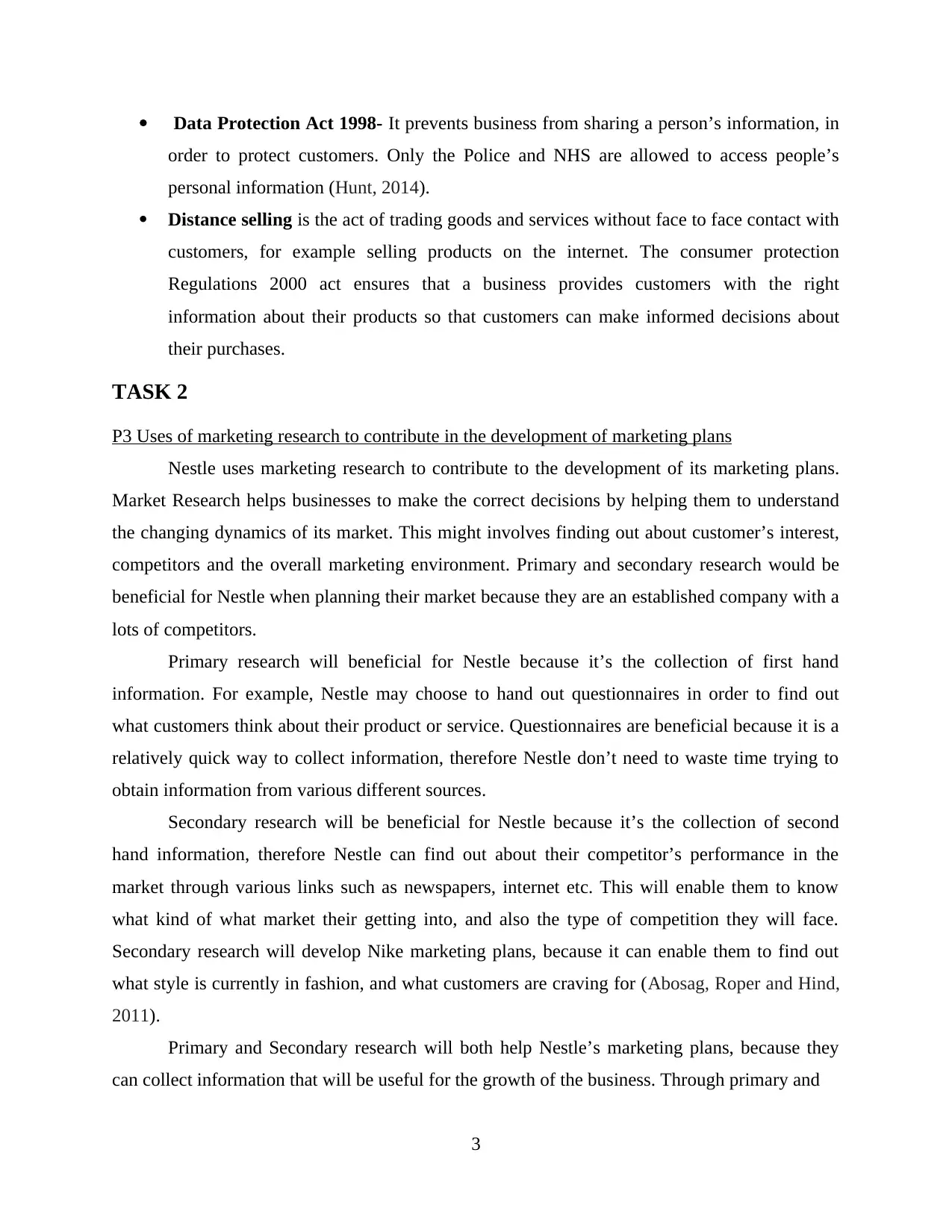
Data Protection Act 1998- It prevents business from sharing a person’s information, in
order to protect customers. Only the Police and NHS are allowed to access people’s
personal information (Hunt, 2014).
Distance selling is the act of trading goods and services without face to face contact with
customers, for example selling products on the internet. The consumer protection
Regulations 2000 act ensures that a business provides customers with the right
information about their products so that customers can make informed decisions about
their purchases.
TASK 2
P3 Uses of marketing research to contribute in the development of marketing plans
Nestle uses marketing research to contribute to the development of its marketing plans.
Market Research helps businesses to make the correct decisions by helping them to understand
the changing dynamics of its market. This might involves finding out about customer’s interest,
competitors and the overall marketing environment. Primary and secondary research would be
beneficial for Nestle when planning their market because they are an established company with a
lots of competitors.
Primary research will beneficial for Nestle because it’s the collection of first hand
information. For example, Nestle may choose to hand out questionnaires in order to find out
what customers think about their product or service. Questionnaires are beneficial because it is a
relatively quick way to collect information, therefore Nestle don’t need to waste time trying to
obtain information from various different sources.
Secondary research will be beneficial for Nestle because it’s the collection of second
hand information, therefore Nestle can find out about their competitor’s performance in the
market through various links such as newspapers, internet etc. This will enable them to know
what kind of what market their getting into, and also the type of competition they will face.
Secondary research will develop Nike marketing plans, because it can enable them to find out
what style is currently in fashion, and what customers are craving for (Abosag, Roper and Hind,
2011).
Primary and Secondary research will both help Nestle’s marketing plans, because they
can collect information that will be useful for the growth of the business. Through primary and
3
order to protect customers. Only the Police and NHS are allowed to access people’s
personal information (Hunt, 2014).
Distance selling is the act of trading goods and services without face to face contact with
customers, for example selling products on the internet. The consumer protection
Regulations 2000 act ensures that a business provides customers with the right
information about their products so that customers can make informed decisions about
their purchases.
TASK 2
P3 Uses of marketing research to contribute in the development of marketing plans
Nestle uses marketing research to contribute to the development of its marketing plans.
Market Research helps businesses to make the correct decisions by helping them to understand
the changing dynamics of its market. This might involves finding out about customer’s interest,
competitors and the overall marketing environment. Primary and secondary research would be
beneficial for Nestle when planning their market because they are an established company with a
lots of competitors.
Primary research will beneficial for Nestle because it’s the collection of first hand
information. For example, Nestle may choose to hand out questionnaires in order to find out
what customers think about their product or service. Questionnaires are beneficial because it is a
relatively quick way to collect information, therefore Nestle don’t need to waste time trying to
obtain information from various different sources.
Secondary research will be beneficial for Nestle because it’s the collection of second
hand information, therefore Nestle can find out about their competitor’s performance in the
market through various links such as newspapers, internet etc. This will enable them to know
what kind of what market their getting into, and also the type of competition they will face.
Secondary research will develop Nike marketing plans, because it can enable them to find out
what style is currently in fashion, and what customers are craving for (Abosag, Roper and Hind,
2011).
Primary and Secondary research will both help Nestle’s marketing plans, because they
can collect information that will be useful for the growth of the business. Through primary and
3
⊘ This is a preview!⊘
Do you want full access?
Subscribe today to unlock all pages.

Trusted by 1+ million students worldwide
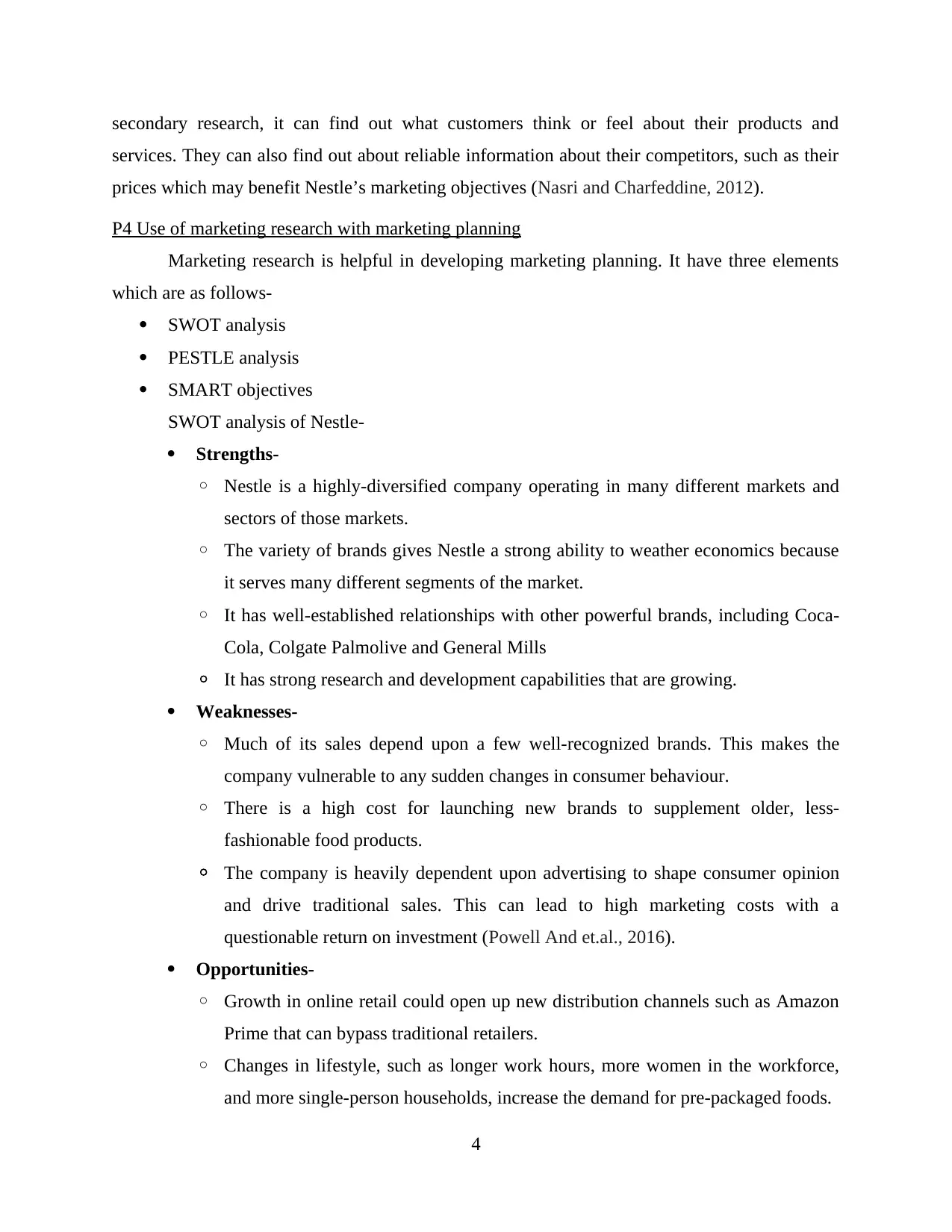
secondary research, it can find out what customers think or feel about their products and
services. They can also find out about reliable information about their competitors, such as their
prices which may benefit Nestle’s marketing objectives (Nasri and Charfeddine, 2012).
P4 Use of marketing research with marketing planning
Marketing research is helpful in developing marketing planning. It have three elements
which are as follows-
SWOT analysis
PESTLE analysis
SMART objectives
SWOT analysis of Nestle-
Strengths-
◦ Nestle is a highly-diversified company operating in many different markets and
sectors of those markets.
◦ The variety of brands gives Nestle a strong ability to weather economics because
it serves many different segments of the market.
◦ It has well-established relationships with other powerful brands, including Coca-
Cola, Colgate Palmolive and General Mills
◦ It has strong research and development capabilities that are growing.
Weaknesses-
◦ Much of its sales depend upon a few well-recognized brands. This makes the
company vulnerable to any sudden changes in consumer behaviour.
◦ There is a high cost for launching new brands to supplement older, less-
fashionable food products.
◦ The company is heavily dependent upon advertising to shape consumer opinion
and drive traditional sales. This can lead to high marketing costs with a
questionable return on investment (Powell And et.al., 2016).
Opportunities-
◦ Growth in online retail could open up new distribution channels such as Amazon
Prime that can bypass traditional retailers.
◦ Changes in lifestyle, such as longer work hours, more women in the workforce,
and more single-person households, increase the demand for pre-packaged foods.
4
services. They can also find out about reliable information about their competitors, such as their
prices which may benefit Nestle’s marketing objectives (Nasri and Charfeddine, 2012).
P4 Use of marketing research with marketing planning
Marketing research is helpful in developing marketing planning. It have three elements
which are as follows-
SWOT analysis
PESTLE analysis
SMART objectives
SWOT analysis of Nestle-
Strengths-
◦ Nestle is a highly-diversified company operating in many different markets and
sectors of those markets.
◦ The variety of brands gives Nestle a strong ability to weather economics because
it serves many different segments of the market.
◦ It has well-established relationships with other powerful brands, including Coca-
Cola, Colgate Palmolive and General Mills
◦ It has strong research and development capabilities that are growing.
Weaknesses-
◦ Much of its sales depend upon a few well-recognized brands. This makes the
company vulnerable to any sudden changes in consumer behaviour.
◦ There is a high cost for launching new brands to supplement older, less-
fashionable food products.
◦ The company is heavily dependent upon advertising to shape consumer opinion
and drive traditional sales. This can lead to high marketing costs with a
questionable return on investment (Powell And et.al., 2016).
Opportunities-
◦ Growth in online retail could open up new distribution channels such as Amazon
Prime that can bypass traditional retailers.
◦ Changes in lifestyle, such as longer work hours, more women in the workforce,
and more single-person households, increase the demand for pre-packaged foods.
4
Paraphrase This Document
Need a fresh take? Get an instant paraphrase of this document with our AI Paraphraser
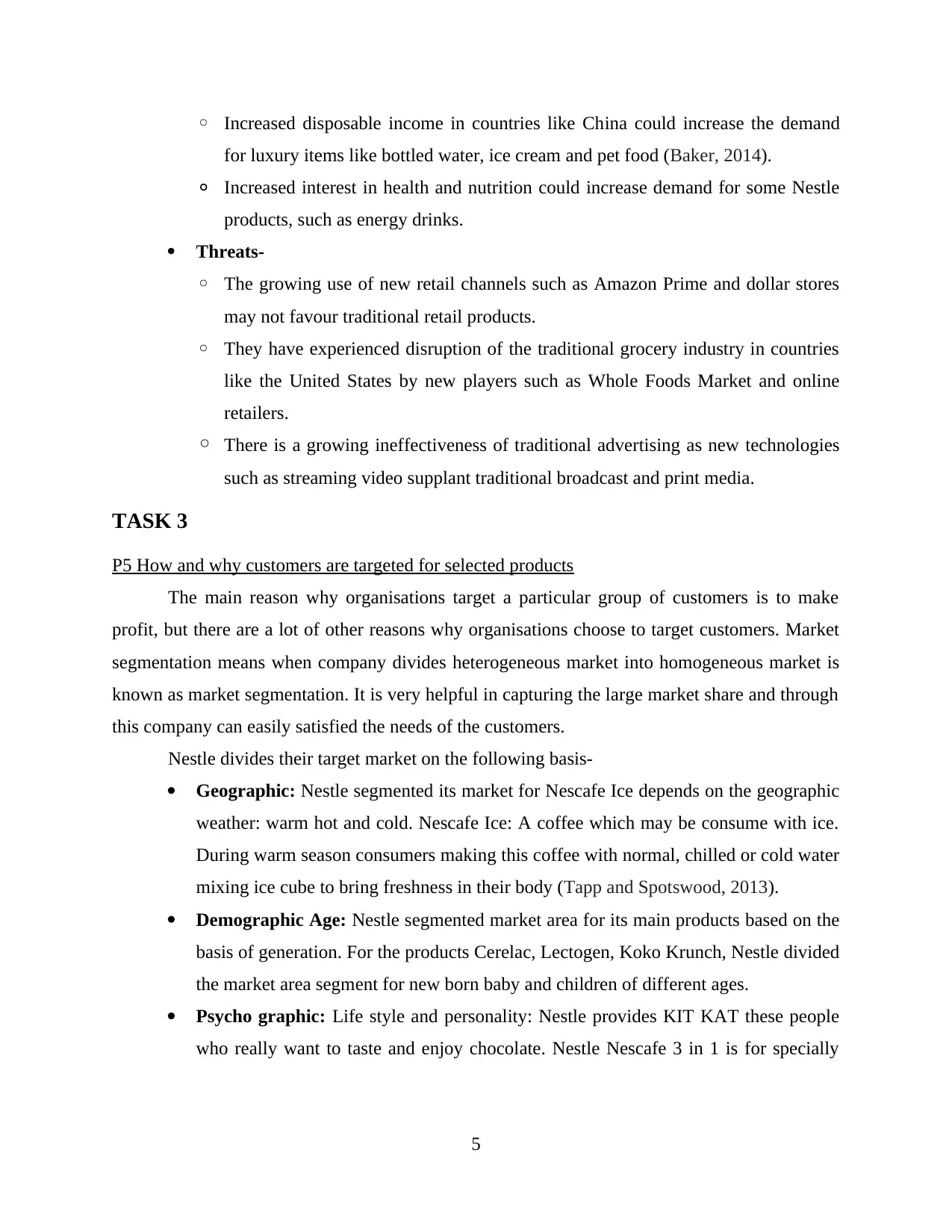
◦ Increased disposable income in countries like China could increase the demand
for luxury items like bottled water, ice cream and pet food (Baker, 2014).
◦ Increased interest in health and nutrition could increase demand for some Nestle
products, such as energy drinks.
Threats-
◦ The growing use of new retail channels such as Amazon Prime and dollar stores
may not favour traditional retail products.
◦ They have experienced disruption of the traditional grocery industry in countries
like the United States by new players such as Whole Foods Market and online
retailers.
◦ There is a growing ineffectiveness of traditional advertising as new technologies
such as streaming video supplant traditional broadcast and print media.
TASK 3
P5 How and why customers are targeted for selected products
The main reason why organisations target a particular group of customers is to make
profit, but there are a lot of other reasons why organisations choose to target customers. Market
segmentation means when company divides heterogeneous market into homogeneous market is
known as market segmentation. It is very helpful in capturing the large market share and through
this company can easily satisfied the needs of the customers.
Nestle divides their target market on the following basis-
Geographic: Nestle segmented its market for Nescafe Ice depends on the geographic
weather: warm hot and cold. Nescafe Ice: A coffee which may be consume with ice.
During warm season consumers making this coffee with normal, chilled or cold water
mixing ice cube to bring freshness in their body (Tapp and Spotswood, 2013).
Demographic Age: Nestle segmented market area for its main products based on the
basis of generation. For the products Cerelac, Lectogen, Koko Krunch, Nestle divided
the market area segment for new born baby and children of different ages.
Psycho graphic: Life style and personality: Nestle provides KIT KAT these people
who really want to taste and enjoy chocolate. Nestle Nescafe 3 in 1 is for specially
5
for luxury items like bottled water, ice cream and pet food (Baker, 2014).
◦ Increased interest in health and nutrition could increase demand for some Nestle
products, such as energy drinks.
Threats-
◦ The growing use of new retail channels such as Amazon Prime and dollar stores
may not favour traditional retail products.
◦ They have experienced disruption of the traditional grocery industry in countries
like the United States by new players such as Whole Foods Market and online
retailers.
◦ There is a growing ineffectiveness of traditional advertising as new technologies
such as streaming video supplant traditional broadcast and print media.
TASK 3
P5 How and why customers are targeted for selected products
The main reason why organisations target a particular group of customers is to make
profit, but there are a lot of other reasons why organisations choose to target customers. Market
segmentation means when company divides heterogeneous market into homogeneous market is
known as market segmentation. It is very helpful in capturing the large market share and through
this company can easily satisfied the needs of the customers.
Nestle divides their target market on the following basis-
Geographic: Nestle segmented its market for Nescafe Ice depends on the geographic
weather: warm hot and cold. Nescafe Ice: A coffee which may be consume with ice.
During warm season consumers making this coffee with normal, chilled or cold water
mixing ice cube to bring freshness in their body (Tapp and Spotswood, 2013).
Demographic Age: Nestle segmented market area for its main products based on the
basis of generation. For the products Cerelac, Lectogen, Koko Krunch, Nestle divided
the market area segment for new born baby and children of different ages.
Psycho graphic: Life style and personality: Nestle provides KIT KAT these people
who really want to taste and enjoy chocolate. Nestle Nescafe 3 in 1 is for specially
5
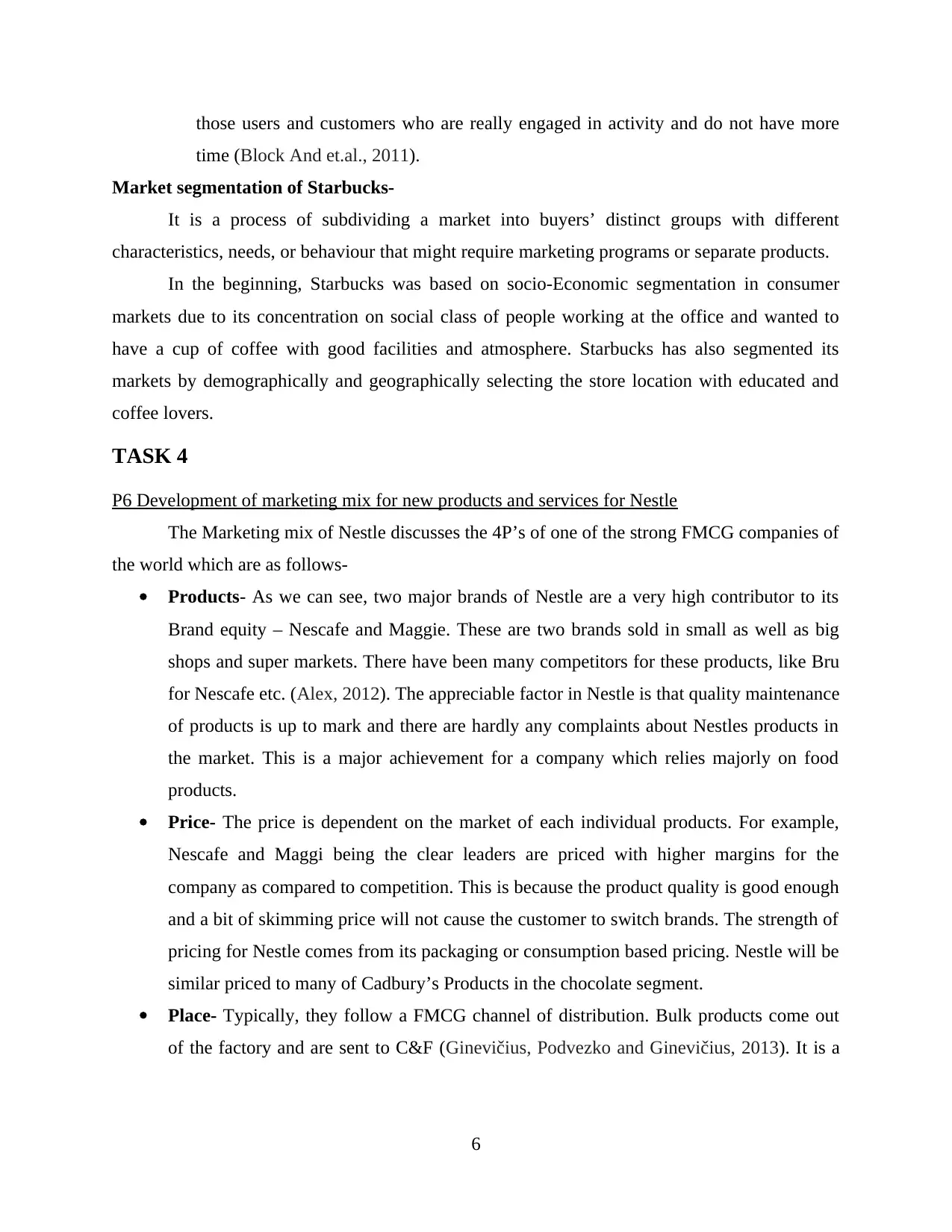
those users and customers who are really engaged in activity and do not have more
time (Block And et.al., 2011).
Market segmentation of Starbucks-
It is a process of subdividing a market into buyers’ distinct groups with different
characteristics, needs, or behaviour that might require marketing programs or separate products.
In the beginning, Starbucks was based on socio-Economic segmentation in consumer
markets due to its concentration on social class of people working at the office and wanted to
have a cup of coffee with good facilities and atmosphere. Starbucks has also segmented its
markets by demographically and geographically selecting the store location with educated and
coffee lovers.
TASK 4
P6 Development of marketing mix for new products and services for Nestle
The Marketing mix of Nestle discusses the 4P’s of one of the strong FMCG companies of
the world which are as follows-
Products- As we can see, two major brands of Nestle are a very high contributor to its
Brand equity – Nescafe and Maggie. These are two brands sold in small as well as big
shops and super markets. There have been many competitors for these products, like Bru
for Nescafe etc. (Alex, 2012). The appreciable factor in Nestle is that quality maintenance
of products is up to mark and there are hardly any complaints about Nestles products in
the market. This is a major achievement for a company which relies majorly on food
products.
Price- The price is dependent on the market of each individual products. For example,
Nescafe and Maggi being the clear leaders are priced with higher margins for the
company as compared to competition. This is because the product quality is good enough
and a bit of skimming price will not cause the customer to switch brands. The strength of
pricing for Nestle comes from its packaging or consumption based pricing. Nestle will be
similar priced to many of Cadbury’s Products in the chocolate segment.
Place- Typically, they follow a FMCG channel of distribution. Bulk products come out
of the factory and are sent to C&F (Ginevičius, Podvezko and Ginevičius, 2013). It is a
6
time (Block And et.al., 2011).
Market segmentation of Starbucks-
It is a process of subdividing a market into buyers’ distinct groups with different
characteristics, needs, or behaviour that might require marketing programs or separate products.
In the beginning, Starbucks was based on socio-Economic segmentation in consumer
markets due to its concentration on social class of people working at the office and wanted to
have a cup of coffee with good facilities and atmosphere. Starbucks has also segmented its
markets by demographically and geographically selecting the store location with educated and
coffee lovers.
TASK 4
P6 Development of marketing mix for new products and services for Nestle
The Marketing mix of Nestle discusses the 4P’s of one of the strong FMCG companies of
the world which are as follows-
Products- As we can see, two major brands of Nestle are a very high contributor to its
Brand equity – Nescafe and Maggie. These are two brands sold in small as well as big
shops and super markets. There have been many competitors for these products, like Bru
for Nescafe etc. (Alex, 2012). The appreciable factor in Nestle is that quality maintenance
of products is up to mark and there are hardly any complaints about Nestles products in
the market. This is a major achievement for a company which relies majorly on food
products.
Price- The price is dependent on the market of each individual products. For example,
Nescafe and Maggi being the clear leaders are priced with higher margins for the
company as compared to competition. This is because the product quality is good enough
and a bit of skimming price will not cause the customer to switch brands. The strength of
pricing for Nestle comes from its packaging or consumption based pricing. Nestle will be
similar priced to many of Cadbury’s Products in the chocolate segment.
Place- Typically, they follow a FMCG channel of distribution. Bulk products come out
of the factory and are sent to C&F (Ginevičius, Podvezko and Ginevičius, 2013). It is a
6
⊘ This is a preview!⊘
Do you want full access?
Subscribe today to unlock all pages.

Trusted by 1+ million students worldwide
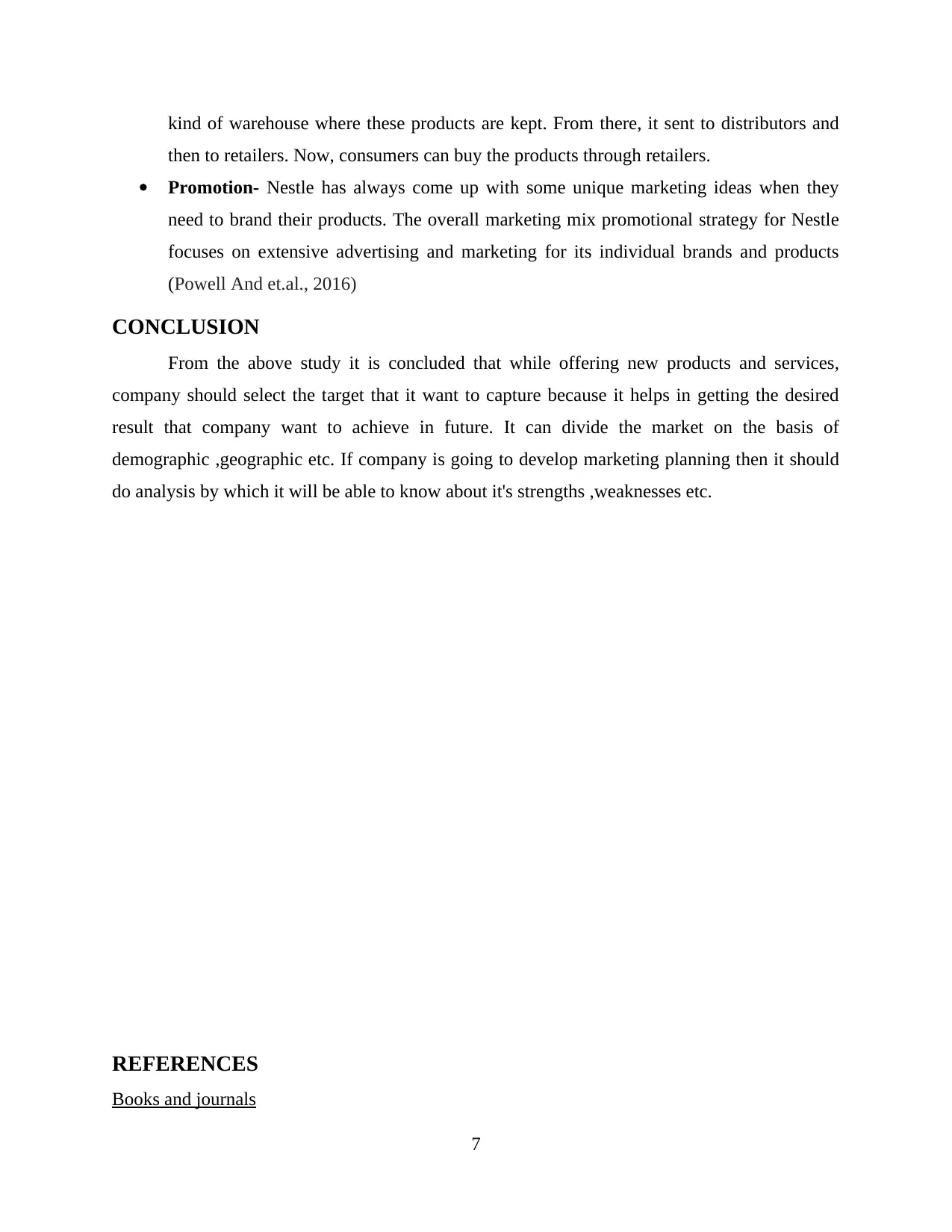
kind of warehouse where these products are kept. From there, it sent to distributors and
then to retailers. Now, consumers can buy the products through retailers.
Promotion- Nestle has always come up with some unique marketing ideas when they
need to brand their products. The overall marketing mix promotional strategy for Nestle
focuses on extensive advertising and marketing for its individual brands and products
(Powell And et.al., 2016)
CONCLUSION
From the above study it is concluded that while offering new products and services,
company should select the target that it want to capture because it helps in getting the desired
result that company want to achieve in future. It can divide the market on the basis of
demographic ,geographic etc. If company is going to develop marketing planning then it should
do analysis by which it will be able to know about it's strengths ,weaknesses etc.
REFERENCES
Books and journals
7
then to retailers. Now, consumers can buy the products through retailers.
Promotion- Nestle has always come up with some unique marketing ideas when they
need to brand their products. The overall marketing mix promotional strategy for Nestle
focuses on extensive advertising and marketing for its individual brands and products
(Powell And et.al., 2016)
CONCLUSION
From the above study it is concluded that while offering new products and services,
company should select the target that it want to capture because it helps in getting the desired
result that company want to achieve in future. It can divide the market on the basis of
demographic ,geographic etc. If company is going to develop marketing planning then it should
do analysis by which it will be able to know about it's strengths ,weaknesses etc.
REFERENCES
Books and journals
7
Paraphrase This Document
Need a fresh take? Get an instant paraphrase of this document with our AI Paraphraser
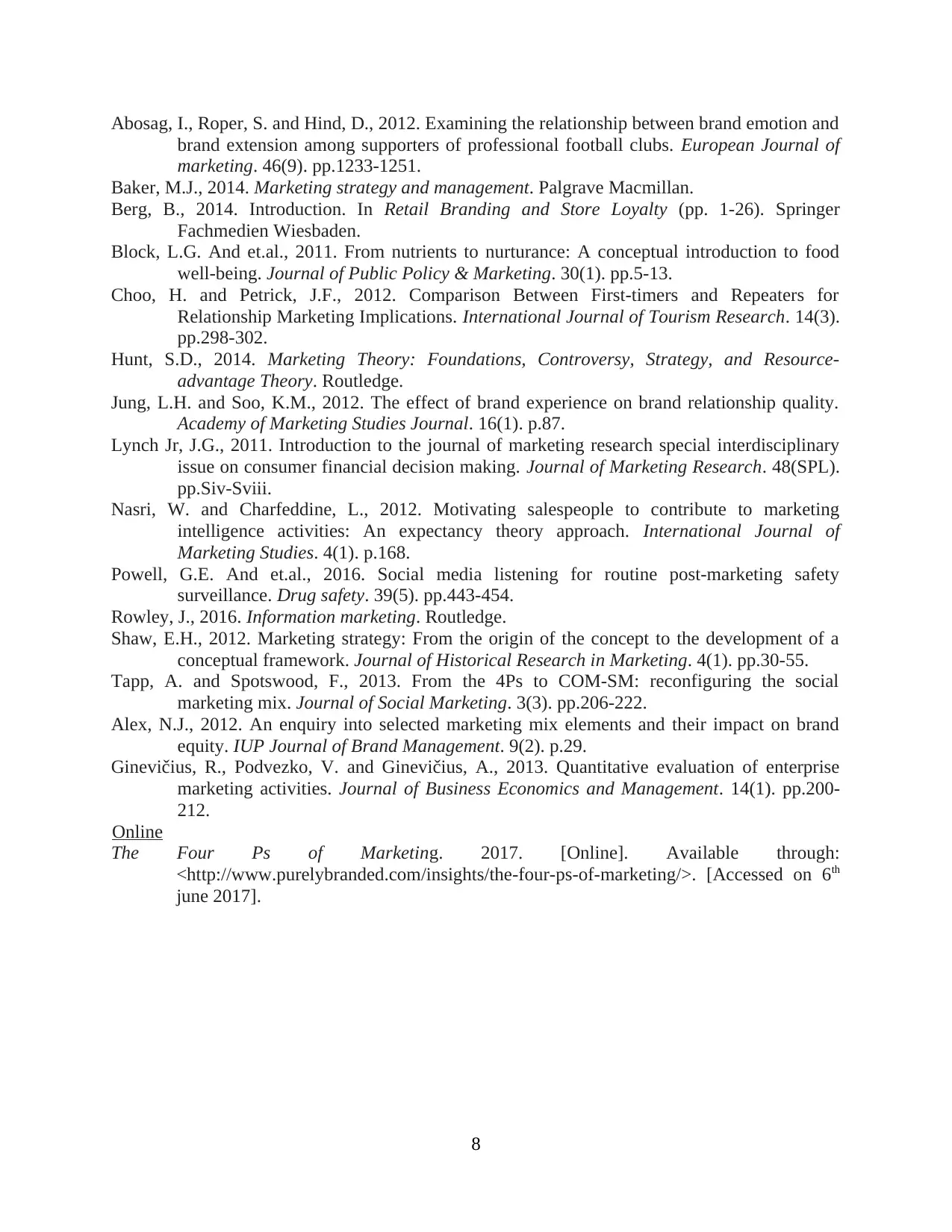
Abosag, I., Roper, S. and Hind, D., 2012. Examining the relationship between brand emotion and
brand extension among supporters of professional football clubs. European Journal of
marketing. 46(9). pp.1233-1251.
Baker, M.J., 2014. Marketing strategy and management. Palgrave Macmillan.
Berg, B., 2014. Introduction. In Retail Branding and Store Loyalty (pp. 1-26). Springer
Fachmedien Wiesbaden.
Block, L.G. And et.al., 2011. From nutrients to nurturance: A conceptual introduction to food
well-being. Journal of Public Policy & Marketing. 30(1). pp.5-13.
Choo, H. and Petrick, J.F., 2012. Comparison Between First‐timers and Repeaters for
Relationship Marketing Implications. International Journal of Tourism Research. 14(3).
pp.298-302.
Hunt, S.D., 2014. Marketing Theory: Foundations, Controversy, Strategy, and Resource-
advantage Theory. Routledge.
Jung, L.H. and Soo, K.M., 2012. The effect of brand experience on brand relationship quality.
Academy of Marketing Studies Journal. 16(1). p.87.
Lynch Jr, J.G., 2011. Introduction to the journal of marketing research special interdisciplinary
issue on consumer financial decision making. Journal of Marketing Research. 48(SPL).
pp.Siv-Sviii.
Nasri, W. and Charfeddine, L., 2012. Motivating salespeople to contribute to marketing
intelligence activities: An expectancy theory approach. International Journal of
Marketing Studies. 4(1). p.168.
Powell, G.E. And et.al., 2016. Social media listening for routine post-marketing safety
surveillance. Drug safety. 39(5). pp.443-454.
Rowley, J., 2016. Information marketing. Routledge.
Shaw, E.H., 2012. Marketing strategy: From the origin of the concept to the development of a
conceptual framework. Journal of Historical Research in Marketing. 4(1). pp.30-55.
Tapp, A. and Spotswood, F., 2013. From the 4Ps to COM-SM: reconfiguring the social
marketing mix. Journal of Social Marketing. 3(3). pp.206-222.
Alex, N.J., 2012. An enquiry into selected marketing mix elements and their impact on brand
equity. IUP Journal of Brand Management. 9(2). p.29.
Ginevičius, R., Podvezko, V. and Ginevičius, A., 2013. Quantitative evaluation of enterprise
marketing activities. Journal of Business Economics and Management. 14(1). pp.200-
212.
Online
The Four Ps of Marketing. 2017. [Online]. Available through:
<http://www.purelybranded.com/insights/the-four-ps-of-marketing/>. [Accessed on 6th
june 2017].
8
brand extension among supporters of professional football clubs. European Journal of
marketing. 46(9). pp.1233-1251.
Baker, M.J., 2014. Marketing strategy and management. Palgrave Macmillan.
Berg, B., 2014. Introduction. In Retail Branding and Store Loyalty (pp. 1-26). Springer
Fachmedien Wiesbaden.
Block, L.G. And et.al., 2011. From nutrients to nurturance: A conceptual introduction to food
well-being. Journal of Public Policy & Marketing. 30(1). pp.5-13.
Choo, H. and Petrick, J.F., 2012. Comparison Between First‐timers and Repeaters for
Relationship Marketing Implications. International Journal of Tourism Research. 14(3).
pp.298-302.
Hunt, S.D., 2014. Marketing Theory: Foundations, Controversy, Strategy, and Resource-
advantage Theory. Routledge.
Jung, L.H. and Soo, K.M., 2012. The effect of brand experience on brand relationship quality.
Academy of Marketing Studies Journal. 16(1). p.87.
Lynch Jr, J.G., 2011. Introduction to the journal of marketing research special interdisciplinary
issue on consumer financial decision making. Journal of Marketing Research. 48(SPL).
pp.Siv-Sviii.
Nasri, W. and Charfeddine, L., 2012. Motivating salespeople to contribute to marketing
intelligence activities: An expectancy theory approach. International Journal of
Marketing Studies. 4(1). p.168.
Powell, G.E. And et.al., 2016. Social media listening for routine post-marketing safety
surveillance. Drug safety. 39(5). pp.443-454.
Rowley, J., 2016. Information marketing. Routledge.
Shaw, E.H., 2012. Marketing strategy: From the origin of the concept to the development of a
conceptual framework. Journal of Historical Research in Marketing. 4(1). pp.30-55.
Tapp, A. and Spotswood, F., 2013. From the 4Ps to COM-SM: reconfiguring the social
marketing mix. Journal of Social Marketing. 3(3). pp.206-222.
Alex, N.J., 2012. An enquiry into selected marketing mix elements and their impact on brand
equity. IUP Journal of Brand Management. 9(2). p.29.
Ginevičius, R., Podvezko, V. and Ginevičius, A., 2013. Quantitative evaluation of enterprise
marketing activities. Journal of Business Economics and Management. 14(1). pp.200-
212.
Online
The Four Ps of Marketing. 2017. [Online]. Available through:
<http://www.purelybranded.com/insights/the-four-ps-of-marketing/>. [Accessed on 6th
june 2017].
8
1 out of 11
Related Documents
Your All-in-One AI-Powered Toolkit for Academic Success.
+13062052269
info@desklib.com
Available 24*7 on WhatsApp / Email
![[object Object]](/_next/static/media/star-bottom.7253800d.svg)
Unlock your academic potential
Copyright © 2020–2025 A2Z Services. All Rights Reserved. Developed and managed by ZUCOL.





